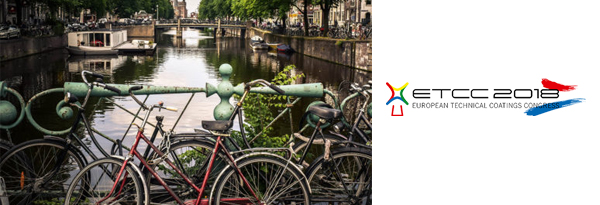ETCC 2018
Exhibitors Avenue, Amsterdam, Netherlands - JUNE 26-29, 2018

THANK YOU FOR YOUR INQUIRY. OUR TEAM WILL BE CONTACTING YOU SHORTLY.
EUROPEAN TECHNICAL COATINGS CONGRESS 2018
The ETCC 2018 event offers an interesting platform for technicians and scientists, active in the world of coatings: raw materials suppliers, coatings companies, universities and research institutes.
Patricia Perez, our Corrosion Inhibitors Product Manager, will present the paper “Ferro Functional Pigments Solutions for Coatings: Deeper Knowledge of Nubirox Anticorrosive Pigments by the Use of Different Techniques.”
Abstract ETCC2018:
Corrosion is recognized as a major problem in modern society and the resulting losses each year are in the hundreds of billions of dollars across many industries. Therefore, it is a key issue to protect metallic surfaces to slow down and minimize the negative impact of corrosion. Coating the surface with an anticorrosive paint is one of the most common ways to achieve this target. In addition to the barrier effect of the coating, corrosion protection can be enhanced in many cases by the use of anticorrosive pigments inside the coating.
Ferro’s range of corrosion inhibitors includes technically efficient anticorrosive pigments (Nubirox) that help coatings formulators achieve present performance requirements for many protective coatings applications. In addition to their effectiveness in slowing down the corrosion of different metal surfaces, Nubirox products are also an environmentally friendly solution for new sustainable coatings, as well as a compatible solution for innovative DTM coatings with additional aesthetics and gloss requirements.
The study of the activity and the behavior of the different particle shapes, chemistries and modifications involved in our Nubirox anticorrosive pigment range has helped us to clarify their activity, their performance inside a coating and their benefits in comparison with conventional pigments:
- Pigment particle shape (characterized by electronic microscopy, SEM) and its specific surface area (measured by BET) were analyzed as a reference of the pigment’s active area, which correlates with its anticorrosive effectiveness.
- The inhibition mechanism of anticorrosive pigments is based on substrate passivation, and it was identified by using electrochemical characterizations (potentiodynamic polarization of a pigment water extract, LSV)
- But the anticorrosive pigment performance inside a coating not only depends on the pigment activity; coating formulation and the anticorrosive pigment interaction with other paint components are also important points to consider. The prediction of anticorrosive properties in coatings is commonly evaluated by international standards like Salt Spray test (ISO 9227, ASTM B117), but modern electrochemical techniques are becoming increasingly useful to obtain additional information about the corrosion process in a short time. In particular, the “Accelerated Cyclic Electrochemical Technique” ACET (ISO17463:2014) was used to study the resistance of the coating to degradation (with cathodic polarizations), besides the common Salt Spray test. The results obtained show how the anticorrosive pigment effectiveness is also reflected in this technique.
The conclusion of the research carried out using these different techniques demonstrates the high effectiveness of our current Nubirox range, and it is part of our fundamentals for the development of future anticorrosive pigments.
